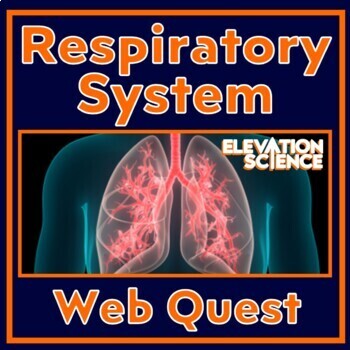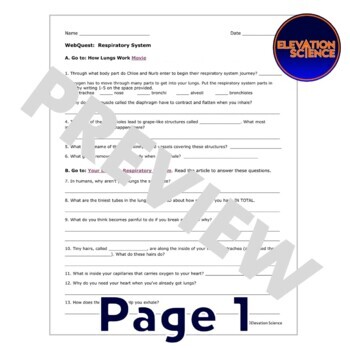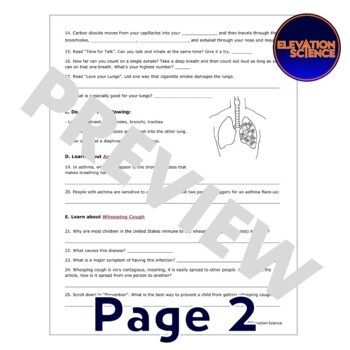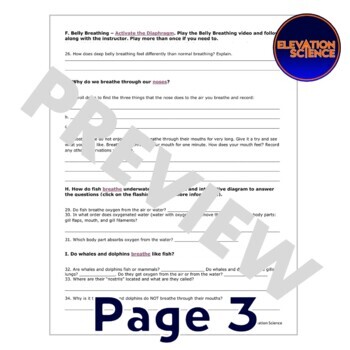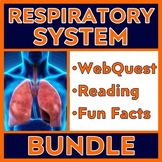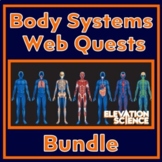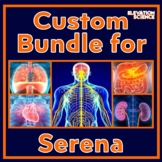Human Body Systems Respiratory System Activity Webquest with Google Docs
Elevation Science
638 Followers
Grade Levels
7th - 10th
Subjects
Resource Type
Standards
CCSSRST.6-8.4
CCSSRST.9-10.4
NGSSMS-LS1-3
Formats Included
- PDF
- Google Apps™
- Webquests
Pages
3 pages
Elevation Science
638 Followers

Includes Google Apps™
The Teacher-Author indicated this resource includes assets from Google Workspace (e.g. docs, slides, etc.).
What educators are saying
This was a great resource for my students to complete to learn about and understand the respiratory system!
This was an excellent resource to get my students to learn about the respiratory system and practice some research skills.
Also included in
- Save 30%!!! Includes three fun and informative activities for the respiratory system.This money-saving bundle includes:Web Quest: Students use the internet to access fun websites to research and answer questions on the Respiratory System.Informational Text: Students will read an article about the fuPrice $7.00Original Price $10.00Save $3.00
- SAVE MORE THAN 40% on 23 NO PREP human body systems activities, including WebQuests, fun facts readings, and informational texts! Body Systems Included:Skeletal System, Digestive System, Circulatory System, Immune System, Respiratory System, Muscular System*, Nervous System, and Excretory System. EaPrice $49.99Original Price $84.19Save $34.20
- SAVE MORE THAN 30% OFF LIST PRICES! ALL 7 WEBQUESTS INCLUDE GOOGLE DOCS AND PDF VERSIONS. Use these organ system webquests cover the basics of seven major human body systems. Each worksheet provides a structured format for students to get the most from the articles, videos, and quizzes provided bPrice $18.99Original Price $28.19Save $9.20
- This is a custom bundle for Serena.Please consider clicking HERE to follow Elevation Science on TPT!Price $33.60Original Price $48.00Save $14.40
Description
GOOGLE DOCS AND PRINT VERSION INCLUDED! This respiratory system worksheet covers the basics of lung parts, lung health, and breathing activities. The worksheet provides a structured format for students to get the most from the articles, videos, and quizzes provided by www.KidsHealth.org and a few other websites.
You may also be interested in our Respiratory System BUNDLE!
This WebQuest has Several Sections:
- Part A – Watch a video to take a journey through the parts of the respiratory system.
- Part B – Learn more about the inner workings of the lungs, ribs, and diaphragm and the movement of gases.
- Part C – Label the parts of the respiratory system.
- Parts D & E – Learn about asthma and whooping cough.
- Part F – Activate the diaphragm and learn deep belly breathing.
- Part G – Learn why we prefer to breathe through our noses through a reading and an activity.
- Part H & I – Find out... do fish have lungs? Do whales and dolphins have gills?
Teacher Notes:
- This resource is not editable.
- A link to the Google Docs version is provided in the downloadable PDF.
- Includes answer key.
- Get this resource at a discount in our Body Systems WebQuest Bundle!
Please consider clicking HERE to follow Elevation Science on TPT!
Total Pages
3 pages
Answer Key
Included
Teaching Duration
N/A
Report this resource to TPT
Reported resources will be reviewed by our team. Report this resource to let us know if this resource violates TPT’s content guidelines.
Standards
to see state-specific standards (only available in the US).
CCSSRST.6-8.4
Determine the meaning of symbols, key terms, and other domain-specific words and phrases as they are used in a specific scientific or technical context relevant to grades 6–8 texts and topics.
CCSSRST.9-10.4
Determine the meaning of symbols, key terms, and other domain-specific words and phrases as they are used in a specific scientific or technical context relevant to grades 9–10 texts and topics.
NGSSMS-LS1-3
Use argument supported by evidence for how the body is a system of interacting subsystems composed of groups of cells. Emphasis is on the conceptual understanding that cells form tissues and tissues form organs specialized for particular body functions. Examples could include the interaction of subsystems within a system and the normal functioning of those systems. Assessment does not include the mechanism of one body system independent of others. Assessment is limited to the circulatory, excretory, digestive, respiratory, muscular, and nervous systems.

